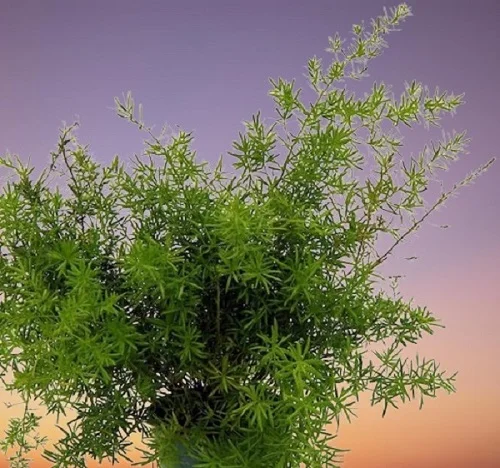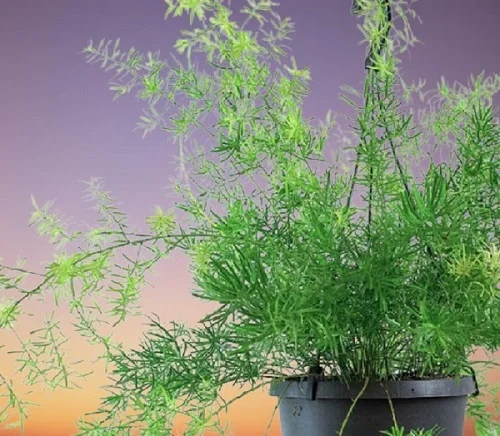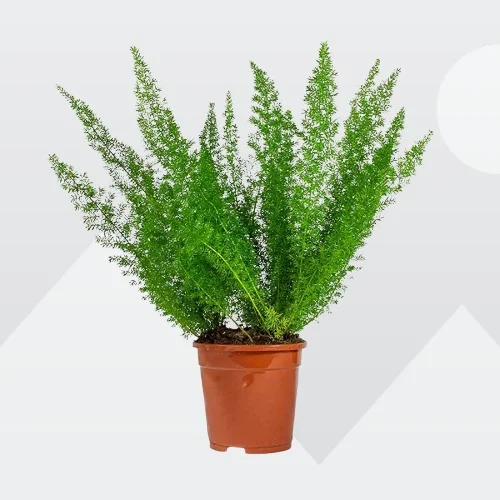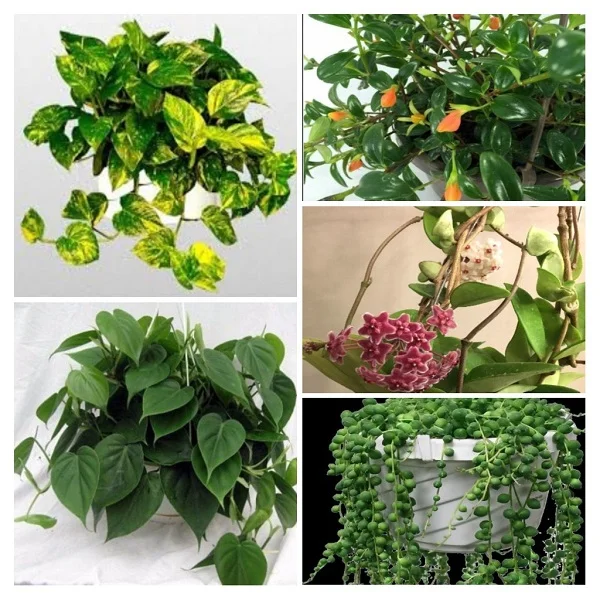Emerald Fern (Asparagus densiflorus 'Sprengeri') Care Indoors, Propagation and Problems
Some links in this post may be affiliate links
Emerald Fern (Asparagus densiflorus 'Sprengeri') prospers in semi-shade to bright indirect light, average warmth, moderate humidity and moderately moist, rich, well-drained, all purpose soils coupled with weekly feeding in the growing season.
Asparagus densiflorus 'Sprengeri' also called Sprenger's Asparagus or Sprenger's Fern is among the popular ornamental Asparagus ferns whose arching stems are sparsely covered with clusters of soft, needle-like foliage.
Sprenger's Asparagus is an evergreen, fern-like plant with trailing stems which bear bright green 'leaves' hence the common name 'Emerald Fern'. The 'leaves' are really needle-like branches.
Though commonly called a fern, Emerald Fern is not among the True Ferns as it is much easier to grow than true ferns. It adapts well to wide variations in light, heat and watering frequency.
Sprenger's Asparagus is perfect for a hanging basket, desktop, plant shelf or pedestal where the stems can cascade downwards beautifully. The Fern can also be grown as an outdoor container plant. It is one of the best plants for the office space.
The name 'Sprenger's Fern' is attributed to Carl Ludwig Sprenger who made it popular in Europe as an ornamental Plant.

Botanical name: Asparagus densiflorus 'Sprengeri'
Synonym: Asparagus sprengeri
Family: Asparagaceae
Sufamily: Asparagoideae
Common names: Emerald Fern, Sprenger's Asparagus, Sprenger's Fern
Origin
Asparagus densiflorus 'Sprengeri' is native to the Cape Provinces and the Northern Provinces of South Africa where it grows in rocky slopes and coastal scrub in dry areas.
Flower
When provided with the right growing conditions, Emerald Fern may produce clusters of small white flowers which are followed by bright red berries.
Size
Emerald Fern habit can be dense and compact to wide-spreading with the stems growing up to 3 feet long. This wide-spreading nature of this fern makes it perfect for a hanging basket.
Toxicity
Emerald Fern like other Asparagus Ferns is toxic to humans and pets as indicated by ASPCA. If the berries are ingested, they can cause vomiting, diarrhea and abdominal pain. If handled with bare hands, the berries can cause contact dermatitis.
The foliage of mature plant can develop sharp spines on the branches which can cause skin irritation if handled with bare hands. Therefore, always wear gloves when handling Sprenger's Asparagus.
Invasiveness
As outlined by Mark Tancig (University of Florida), Asparagus Ferns have been found to be invasive in some regions. Avoid growing Asparagus Ferns in the ground and dispose them by burning as they grow vigorously, spreading across and scrambling up other plants.
Where to Buy
Would you like to add Emerald Fern to your collection? They are available online on Etsy (Link to Etsy).
Asparagus densiflorus 'Sprengeri' Care Indoors
Emerald Fern (Asparagus densiflorus 'Sprengeri') flourishes in semi-shade to bright indirect light (filtered light), average warmth of 18-280C, moderate humidity of 60-70% and moderately moist, fertile, well-drained, all purpose soils coupled with weekly feeding during the growing season.
Sprenger's Asparagus requires regular pruning to keep it neat and tidy as well as minimize pest and disease infestations. It only requires repotting when pot-bound. Keep reading for more on these growing conditions and how to provide them.

Watering
Water Emerald Fern thoroughly during the growing season while allowing the top 2-3 inches of soil to dry out between waterings and keep the soil moderately moist.
Cut down on watering in the cold period as growth is reduced at this time but do not let the soil dry out completely. Occasionally water from the bottom to ensure that the soil ball is thoroughly wetted.
Make sure that the pot has a drainage hole to prevent the soil from getting soggy as it can lead to root-rot and eventual death of the fern. Read more on how to water houseplants the right way.
Light Requirements
Emerald Fern grows best in semi-shade to bright light conditions. Keep it away from direct sunlight as it can scorch the leaves.
If it does not receive adequate light the leaves will lose their color and turn yellowish. You may grow Asparagus densiflorus 'Sprengeri' under grow lights where the natural lighting is not adequate. Check out these full spectrum grow lights on Amazon.
Temperature and Humidity
Average warmth of 18-280C is ideal for Emerald Fern. Though it can adapt to a wide range of temperatures, constantly high temperatures can damage the plant.
Emerald Fern has no need for extra humidity. Moderate humidity of 50-60% is adequate for this fern. However, it benefits from occasional misting of the leaves especially where the temperatures are very high.
Potting Mix
The best potting mix for Emerald Fern should be rich in organic matter and free-draining to prevent it from getting soggy while providing the required nutrients. All purpose potting mixes are ideal.
Fertilizer
Feed Emerald Fern with a balanced, liquid fertilizer once a week during the growing season to encourage a lush growth. Withhold feeding during the cold season as growth is minimal. Read more on how to feed houseplants.
Repotting
Repot Emerald Fern at the beginning of the growing season only when it becomes root-bound, that is, when the roots begin to grow through the drainage holes.
Use a pot 1 size larger than the current one and ensure that it has a drainage hole to avoid soggy soil which can lead to root-rot.
You may divide the large Sprenger's Asparagus Ferns during repotting to propagate new plants. Take a look at these Pots with Multi Mesh Drainage Holes on Amazon.
Pruning
Pruning Emerald Fern requires cutting back of the old stems to make room for new growth.
Trim the dead leaves and branches to keep the Sprenger's Asparagus neat and tidy and also discourage pest and disease infestations. Read more on how to prune houseplants.
Emerald Fern Propagation
Emerald Fern (Asparagus densiflorus 'Sprengeri') is propagated at the beginning of the growing season from seeds or by plant division. The easiest method of propagation is by plant division.
Learn how to propagate Asparagus Ferns in 3 easy ways.

Asparagus densiflorus 'Sprengeri' Problems
Emerald Fern (Asparagus densiflorus 'Sprengeri') problems are yellowing and dropping leaves, plant death, diseases and pests among others. Keep reading for more on these problems and how to fix them.
Leaves yellowing and dropping
Yellowing and dropping leaves in Emerald Fern are caused by several varied reasons. One possible reason is too little light. Position the fern in a brighter spot where it will receive medium to bright indirect light or instal a grow light if the natural lighting is not adequate.
The second possible reason for yellowing and dropping leaves in Emerald Fern is a prolonged period of underwatering. Water the fern thoroughly during the growing season while allowing the top 2-3 inches of soil to dry out between waterings and maintain the soil moderately moist.
Decrease watering in the cold period as growth is reduced at this time but do not let the soil dry out completely. Learn more on how to water indoor plants the correct way.
The third possible reason for yellowing and dropping leaves in Emerald Fern is too high temperatures due to exposure to hot drafts. Keep the fern away from hot drafts like heating units and other hot surfaces to maintain an average room temperature of 18-280C.
Read more on these 12 Reasons Why Asparagus Fern Leaves are Yellowing and Dropping (with solutions)
Plant dying
Sudden death of Emerald Fern is due to root-rot disease which is enhanced by soggy soil brought about by poor drainage of the soil. The thick, tuberous roots store water, therefore, soggy soil will cause them to rot which will lead to the death of the plant.
Make sure that the soil is loose and free-draining and the pot has a drainage hole to avoid getting soggy soil. Read more on how to treat root-rot disease in houseplants.
Diseases
Besides root-rot disease, Emerald Fern is also prone to crown-rot and stem-rot which is prevalent in poorly ventilated and overwet conditions. Improve ventilation and ensure that there is free air circulation.
Isolated the affected plant to prevent spread of the disease to the other houseplants and treat it appropriately for crown-rot and stem-rot disease.
Pests
Common pests in Emerald Fern are spider mites, aphids, mealy bugs and whiteflies whose infestation is enhanced by either overwatering or underwatering.
Maintain the soil moderately moist during the growing period and slightly moist in the cold period but never let the soil dry out completely to keep these pests away. Read more on how to identify and get rid of pests in houseplants.
You liked it? Share on social media.
Related Content
Amazon Associates Disclosure
Homeplantsguide.com is a participant in the Amazon Services LLC Associates Program, an affiliate advertising program designed to provide a means for sites to earn advertising fees by advertising and linking to amazon.com.





